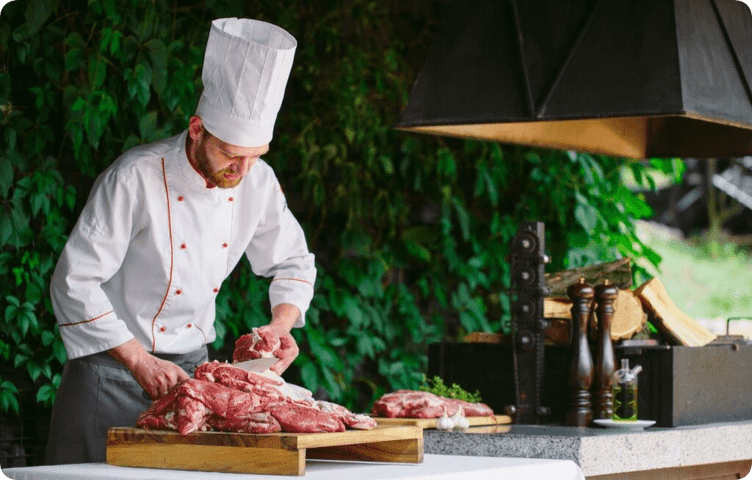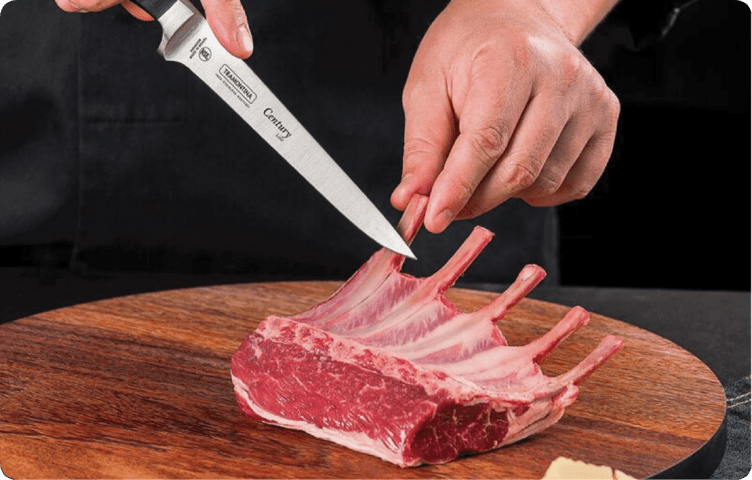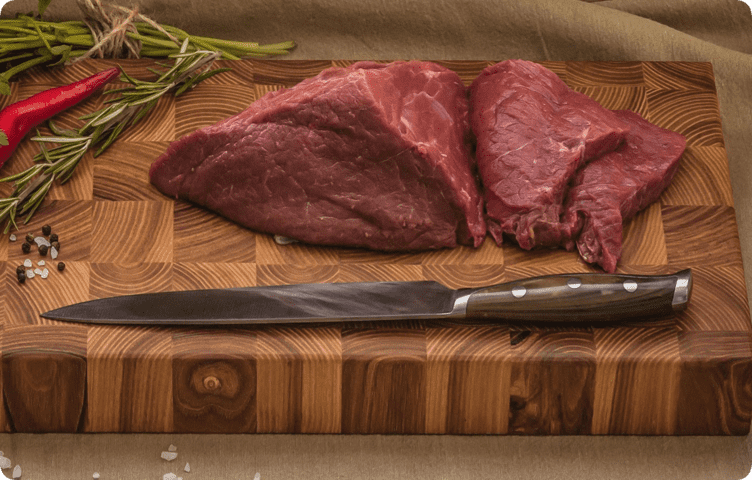One of the most useful kitchen accessories is a boning knife . This sharp tool with a flexible blade is commonly used by professional butchers and hunters. But the product will also come in handy for the average cook when he needs to quickly cut up chickens, turkeys, and meat with bones. Let's figure out how to choose this practical kitchen tool.
What is a boning knife
The main purpose of the tool is to cut ligaments and connective tissue, to separate skin from meat carcasses and fish. The sharp tip allows you to maneuver in difficult places, cutting out the pulp. The design of the product helps to minimize damage to bones and fillets.
Typically, boning knives are used in meat processing plants, hunting, and the fishing industry. Professional chefs in restaurants use this model when cutting game, meat and large fish.

Why do you need a boning knife?
The tool is indispensable for removing skin and fat from pork tenderloin and rack of lamb. The thin and flexible blade removes connective tissue without trapping the pulp. When cutting poultry, a sharp blade easily cuts through the cartilage , separating the breast, drumsticks and thighs.
A boning knife perfectly peels vegetables and fruits with a hard crust - melon, pineapple, mango. The sharp tip makes it easy to core apples and tomatoes .
Homemade bakers use a boning knife to separate cake layers, smooth out the edges of layer cakes, and cut out circles and hearts in the middle of cakes.
Kinds
Based on their shape and function, there are 5 types of boning knives:
- hard – equipped with a straight blade with a length of 16.5 to 22.5 cm. Used for separating bones, fat, and cartilage. Suitable for cutting large pieces of beef, pork, sea fish;
- flexible – characterized by a curved elastic blade. The length of the product is 12.5-16.5 cm. Designed for careful cutting and delicate operations such as removing skin from fish and poultry;
- serrated - has teeth on the cutting edge. Convenient for sawing tendons, cartilage, and thin bones. Used for slicing game and fish;
- folding - a portable option for hunters and fishermen. Equipped with a durable handle with a folding mechanism, smaller in size than kitchen models;
- electric – runs on electric drive or batteries. Used in procurement and fish processing plants.
Common features for all five types are a massive handle and a small protrusion at the base of the blade.

Design features of boning knife
The appearance of the product corresponds to its purpose - a narrow knife blade in the shape of the letter V, a long tip, a heavy streamlined handle. There is a finger guard on the back of the blade.
Blade
The main part of the knife is designed in such a way as to make cutting operations as easy as possible. The classic version of the blade is flexible, with a narrow tip, easily moving along the contours of the bones. There are also models for specific types of meat, for example:
- hard – used for separating beef and lamb tenderloin, preparing pieces for steaks;
- curved - necessary for cutting poultry, game, fish, removing the skin;
- narrow – used for working in difficult areas of the carcass;
- wide – used for cutting large fillets.
Blades are usually made of steel - stainless, high-carbon or hardened. There is no significant difference between these materials; each of them provides high strength and sharpness of the product.
Lever
This part of the boning knife receives the most pressure, so it is always wider than the blade. For the manufacture of handles, durable materials are used - thermoplastic, stainless steel. The shape is usually adapted to the palm of the hand. The surface of the handles is often supplemented with notches, a relief pattern or an anti-slip coating. At the connection to the blade there is a stopper or metal pad to protect the hands.
How to choose?
The type of tool depends on the job for which it is intended and the products you intend to cut. For beef, a straight, wide blade is more suitable; for fish and poultry, a curved one is more suitable.
Here are three more points to pay attention to:
blade material – the best option for a home kitchen would be stainless or high-carbon steel. For restaurant use, select a productmade of hardened steel;
handle – it should fit comfortably in the palm of your hand and not slip. A wooden or polypropylene handle is suitable for home use. Chefs and hunters prefer all-metal knives, but they are too heavy for everyday cooking;
size - the average length of the blade is 13-15 cm. The shorter the blade, the greater its flexibility. But to work with large pieces of meat, it is recommended to choose large tools with a length of 20-22 cm.
Also check what steel hardness is indicated in the instructions. The indicator should not be less than 56 HRC.

How to use a boning knife
If you have not used a tool like this before, it will take some time to get used to its shape. The first thing you need to learn is to grip the handle with three fingers at once, the thumb, middle and ring fingers. Then place your index finger on the top edge of the blade. Use light finger pressure to guide the blade as it moves over bones and skin. Hold the meat with your other hand while slicing. Make sure that the fingers of this hand are always bent to avoid cuts.
If you need to remove the skin from a bird or fish, place the product on a board and make a 3-4 cm long cut on one edge. Smoothly slide the blade between the flesh and the skin, carefully moving it away from you.
Features of care and storage
Wash the boning knife with warm water and soap soon after use. Do not put the tool in the dishwasher unless the instructions say so. Soaking is not recommended, as water is harmful even to stainless steel. If there is food residue stuck to the blade, remove it with a soft brush or cloth. Wipe the clean product dry with a soft cloth.
Do not put the knife in a drawer with other cutlery. Contact with metal objects gradually damages the blade. Use a magnetic stand or knife block for storage.
















































/https%3A%2F%2Fcomplexbar.com%2Fimages%2Fblog%2F243%2Fnozh_ob_glavn.jpg)
/https%3A%2F%2Fcomplexbar.com%2Fimages%2Fblog%2F246%2Fsirop_scale_2400.jpeg)
/https%3A%2F%2Fcomplexbar.com%2Fimages%2Fblog%2F246%2Fkofe-vostochniy.jpg)
/https%3A%2F%2Fcomplexbar.com%2Fimages%2Fblog%2F245%2Fpexels-jason-villanueva-851555.jpg)
/https%3A%2F%2Fcomplexbar.com%2Fimages%2Fblog%2F246%2F2024-04-09_17.22.54.jpg)
/https%3A%2F%2Fcomplexbar.com%2Fimages%2Fblog%2F246%2F2024-04-09_17.22.47.jpg)
/https%3A%2F%2Fcomplexbar.com%2Fimages%2Fblog%2F246%2FCODE_anons_foamydrops_752%D1%85480_eng.jpg)
/https%3A%2F%2Fcomplexbar.com%2Fimages%2Fblog%2F246%2FAlina_752%D1%85480_eng.jpg)
/https%3A%2F%2Fcomplexbar.com%2Fimages%2Fblog%2F246%2F2024-04-09_17.23.22.jpg)
/https%3A%2F%2Fcomplexbar.com%2Fimages%2Fblog%2F246%2F2024-04-09_17.23.28.jpg)
/https%3A%2F%2Fcomplexbar.com%2Fimages%2Fblog%2F246%2F2024-04-09_17.23.35.jpg)
/https%3A%2F%2Fcomplexbar.com%2Fimages%2Fblog%2F246%2Fdrinksome_752%D1%85480_eng.jpg)
/https%3A%2F%2Fcomplexbar.com%2Fimages%2Fblog%2F246%2Fnude_752%D1%85480_eng.jpg)
/https%3A%2F%2Fcomplexbar.com%2Fimages%2Fblog%2F246%2F752%D1%85480_eng__1_.jpg)
/https%3A%2F%2Fcomplexbar.com%2Fimages%2Fblog%2F246%2F752%D1%85480_eng.jpg)
/https%3A%2F%2Fcomplexbar.com%2Fimages%2Fblog%2F246%2FStudioRaw_752%D1%85480_eng.jpg)
/https%3A%2F%2Fcomplexbar.com%2Fimages%2Fblog%2F246%2FDoppio_tea_752%D1%85480_eng.jpg)
/https%3A%2F%2Fcomplexbar.com%2Fimages%2Fblog%2F246%2FTognana_Stars_Stripes_752%D1%85480_eng.jpg)
/https%3A%2F%2Fcomplexbar.com%2Fimages%2Fblog%2F246%2FRona_752%D1%85480_eng.jpg)
/https%3A%2F%2Fcomplexbar.com%2Fimages%2Fblog%2F246%2FDoppio_vending_752%D1%85480_eng.jpg)
/https%3A%2F%2Fcomplexbar.com%2Fimages%2Fblog%2F246%2FEssence_sukhie_smesi_752%D1%85480_eng.jpg)
/https%3A%2F%2Fcomplexbar.com%2Fimages%2Fblog%2F246%2FODK_sukhie_smesi752%D1%85480_eng.jpg)
/https%3A%2F%2Fcomplexbar.com%2Fimages%2Fblog%2F246%2Funiforma-barmena.jpg)
/https%3A%2F%2Fcomplexbar.com%2Fimages%2Fblog%2F246%2Fkak-nanyat-barmena.jpg)
/https%3A%2F%2Fcomplexbar.com%2Fimages%2Fblog%2F246%2Fsirop_scale_2400.jpeg)
/https%3A%2F%2Fcomplexbar.com%2Fimages%2Fblog%2F246%2FPeugeot_Anons_Paris_U%27Select_Line_Daman_752%D1%85480_eng.jpg)
/https%3A%2F%2Fcomplexbar.com%2Fimages%2Fblog%2F246%2Fkofe-vostochniy.jpg)
/https%3A%2F%2Fcomplexbar.com%2Fimages%2Fblog%2F246%2FMadler.jpg)
/https%3A%2F%2Fcomplexbar.com%2Fimages%2Fblog%2F246%2Fprofbartender_glavn.jpeg)